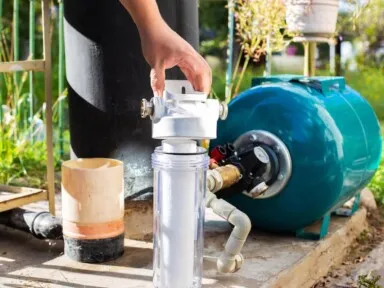According to the most recent U.S. Geological Survey (USGS) on water use, we know that one out of eight households has a private well. Of those wells, 20% contain PFAS or “forever chemicals,” surveyed by USGS in a report from October 2024. Additionally, the Environmental Protection Agency (EPA) warns that climate change has the potential to introduce more ground and surface water contaminants.
That’s why it’s more important than ever to know the contaminants threatening well water systems and what to do about them.
In this article:
- Understanding Well Water Contamination
- Common Well Water Contaminants
- Detecting Contaminants in Well Water
- Treatment Methods for Contaminated Well Water
- Preventing Future Contamination
- Quick Guide to Well Water Contamination
- Maintaining Healthy Well Water
- Frequently Asked Questions
Understanding Well Water Contamination
While public water systems are monitored by local authorities, private well owners are responsible for ensuring their water stays safe. Unfortunately, wells can become contaminated from a variety of sources, both natural and human-made.
Sources of Contamination
According to the EPA, the main five sources of well water contamination are:
- Agricultural (fertilizer, pesticides, etc.)
- Commercial (floor drains, construction sites, etc.)
- Industrial (heavy metals, waste disposal, etc.)
- Residential (septic tank leaks, pool chemical storage, etc.)
- Other (like runoff from road de-icing and illegal dumping)
Outside of human activities, wells can be contaminated from natural occurrences as well. The biggest naturally occurring contaminant is arsenic. For example, arsenic is released from bedrock into groundwater, while radon can enter water supplies as a gas formed from the breakdown of uranium underground.
Health Implications
Drinking contaminated well water can pose serious health effects. These problems can range from stomach or gastrointestinal issues to a higher risk of cancer. Depending on the contaminant, other potential health issues include nervous system damage, organ damage, anemia, skeletal fluorosis (bone and joint tenderness), dental fluorosis (damage to permanent teeth in children), and methemoglobinemia or “blue baby syndrome.” Blue baby syndrome occurs when there isn’t enough oxygen in an infant’s blood, which makes their skin appear blue.
Common Well Water Contaminants
Well water can contain a range of contaminants that fall into three main categories: microbial, chemical, and physical. These contaminants vary based on geography, human activity, and natural groundwater conditions.
USGS data from this section is from their groundwater contaminant concentrations study for groundwater from 2012-2021.
Microbial Contaminants
These are often the most urgent threats to human health, especially when they cause gastrointestinal illness. Per the EPA, they are often caused by pollutants such as animal waste, landfills, and fertilizers.
- Bacteria (e.g., E. coli, coliforms)
- Viruses
- Parasites (e.g., Giardia, Cryptosporidium)
Chemical Contaminants
Often caused by humans through agriculture or industry, chemical contaminants can have dire health impacts, such as the risk of cancer and death. Common pollutants for these contaminants include household plumbing lines, cement plants, chemical fertilizers, and sewage.
- Nitrates and nitrites
- The Central region (states like Texas, Arkansas, Oklahoma) had the highest levels of nitrates due to permeable soil and agricultural fertilizer.
- Heavy metals (lead, arsenic, mercury)
- The East Coast had the highest levels of lead.
- The Midwest had the highest levels of iron.
- The West Coast had the highest levels of strontium, an alkaline earth metal that occurs naturally in the soil.
- Volatile organic compounds (VOCs)
- Polyfluorinated alkyl (PFAS or “forever chemicals”)
- In 2023, USGS announced a new study of tap water across the country. They discovered that 45% of tap water, both city and well water, contained at least one kind of PFAS. USGS noted both public water and private wells had about the same concentration of PFAS.
- Microplastics have also become a common contaminant. In 2017 data, showed 83% of drinking water surveyed across five continents had microplastic in it. That same study indicated 94% of water samples from the United States contained microplastic.
Physical Contaminants
When water is contaminated with a physical pollutant, you can often see it. The water may appear cloudy or change color depending on the contaminant. These can be caused by issues like surface runoff, corroded pipes, or debris.
- Sediments (sand, silt)
- Rust particles
Detecting Contaminants in Well Water
Private well owners must be vigilant of any changes to their home water. Different contaminants will interact with water differently. But if you notice something is amiss, home water testing is the way to go.
Signs of Contamination
Contaminated well water doesn’t always look, taste, or smell different, but there are a few common red flags to watch for:
- Unusual taste or odor
- Discoloration
- Staining on fixtures
- Health symptoms among household members
Please see the more detailed chart below for more information.
Testing Methods
One of the biggest differences between living with city water vs well water is that well owners need to test their drinking water regularly. The EPA advises at least annual testing for “total coliform bacteria, nitrates, total dissolved solids, and pH levels” along with any other potential contaminants. The department also suggests testing more often if you have young children, anyone pregnant/nursing or elderly people in your home. Here are two ways you can easily test your private well water:
- DIY test kits
- Homeowners can purchase tests to do themselves at home. These tests measure issues such as water hardness, bacteria, copper, lead, nitrates/nitrites, and total dissolved solids.
- Leaf Home Free Water Test
- Some of the contaminants in the free LeafHome water test include alkalinity, chlorine, copper, iron, and pH.
Treatment Methods for Contaminated Well Water
If your well water tests positive for contaminants, there are proven ways to treat the water to make it safer again. The right solution depends on what you’re dealing with, from microbes to metals.
Filtration Systems
Water filtration systems, like the ones listed below from Leaf Home, are the first line of defense. Different systems target different contaminants:
- Activated carbon filters: Common in pitcher filters (like a Brita), they use carbon to absorb contaminants. They can remove organic compounds like chlorine, which affect taste and smell. However, they cannot filter certain types of contamination, such as bacteria and viruses.
- Sediment filters: As their name implies, sediment filters remove solid particles like dirt, sand, and rust from water as it passes through.
- Reverse osmosis (RO) systems: RO is a highly effective water filtration system using a semi-permeable membrane to remove up to 99% of contaminants, including parasites, bacteria, viruses, and other harmful chemicals as well as physical contaminants like sediment.
Disinfection Techniques
While filters trap or remove contaminants from water, disinfection targets the source, killing or neutralizing microorganisms before they reach your tap.
- Chlorination: According to the Centers for Disease Control (CDC), public water companies have been using chlorine to disinfect water since 1929. In fact, it is the most widely used method of disinfection in the country, per the National Institutes of Health (NIH). Chlorine and chloramine (compounds with chlorine and ammonia) are effective in eliminating germs in water.
- Ultraviolet (UV) light treatment: Technically, UV water treatment can also be a filtration system. Since the mid-1800s, this method has been a useful way to disinfect water, according to the Journal of Travel Medicine and Infectious Diseases. It utilizes the power of UV to neutralize 99.99% of microorganisms without the use of additional chemicals.
- Boiling (for microbial contaminants): Boiling water to safely use it must be done following safety guidelines from the CDC, and is the old-fashioned standby.
Specialized Treatments
For homes with unique water concerns, advanced treatment systems may be necessary.
- Ion Exchange: This process swaps harmful ions, like lead or nitrate, for harmless ones. It’s commonly used in water softeners and deionization systems.
- Distillation: Home distillers boil water and collect purified steam, leaving contaminants behind. This method removes minerals, salts, and most microbes.
Preventing Future Contamination
While filtration and disinfection systems can treat existing issues, proactive maintenance is key to keeping well water safe in the long run. Here’s how homeowners can reduce the risk of future contamination.
Regular Maintenance
- Periodic well inspections: The CDC recommends doing annual well inspections to check for problems with the well itself.
- Sealing cracks and leaks: It is important to seal any cracks or leaks as they happen. This reduces the number of entry points for potential contaminants.
- Proper landscaping to divert runoff: Homeowners can create a rain garden, which is designed as a landscape depression to collect water runoff. Rain barrels or cisterns can also prevent water from pooling as it comes off the roof.
- Whole home filtration: Know how often to replace the filters in your home filtration system. Some filters need replacement every six to twelve months, while an RO membrane can last three years.
Quick Guide to Well Water Contamination
For a quick contamination reference, consider saving this guide. These are the most common signs that your well water has been contaminated.
| Sign of Contamination | Possible Cause | Recommended Fix |
| Unusual odor (rotten eggs) | Hydrogen sulfide gas or sulfur bacteria | Install activated carbon filters or aeration systems; shock chlorination |
| Metallic taste | High levels of iron, manganese, or zinc | Use water softeners or oxidation filtration systems |
| Cloudy or muddy water | Sediment, silt, or rust | Install sediment filters or flush the well |
| Orange or red stains on fixtures | High iron content | Use iron filters, oxidizing filters, or ion exchange systems |
| Blue-green stains | Low pH (acidic water) causes copper leaching | Neutralizing filters (calcite) to balance pH |
| Salty taste | Saltwater intrusion or high chloride levels | Install a reverse osmosis system; inspect well integrity and location |
| Oily film on the water surface | Organic compounds, petroleum contamination | Contact a professional; install granular activated carbon filters |
| Illness after drinking water | Microbial contamination (e.g., E. coli) | Disinfect water using UV treatment, chlorination, or boiling; test and monitor water |
| Foaming or suds | Detergents or wastewater contamination | Inspect and repair nearby septic systems; consider carbon filtration |
| Bad taste (chemical/medicinal) | VOCs or industrial chemicals | Install activated carbon filters or reverse osmosis systems |
| Discoloration (brown/black) | Manganese, iron, or other minerals | Use oxidation followed by filtration |
| White scale or film on appliances | Hard water (calcium/magnesium) | Install a water softener system |
Maintaining Healthy Well Water
Private well owners have the unique responsibility and opportunity of managing their own water supply. Even with the utmost care, contamination can happen. That’s why it’s essential to regularly test the well water for contaminants and check for any maintenance issues. Consuming contaminated water can be incredibly dangerous, especially for young children, anyone pregnant/breastfeeding, and elderly people.
Fortunately, there are effective solutions. Advanced filtration systems and disinfection methods, like reverse osmosis and UV treatment, can help ensure your well water is cleaner, safer, and reliable without depending on city water.
When you’re ready to take control of your home’s water quality, explore Leaf Home’s Well Water Softener & Filtration Systems.
Frequently Asked Questions
How often should I test my well water?
The CDC recommends testing well water at least once a year. However, they recommend more frequent testing if there are young children, anyone pregnant/breastfeeding, or elderly people in the home.
Can I treat well water contamination myself?
While it is possible for homeowners to treat contaminated well water themselves, it is advised to hire professionals like the experts at Leaf Home. Professional testing and treatment offer peace of mind and ensure your water is truly cleaner and safer to drink.
Is bottled water safer than treated well water?
Not necessarily. Bottled water isn’t more regulated than tap water, and it may still contain contaminants. With proper testing and treatment, well water can be just as safe (and often more sustainable and cost-effective) than relying on bottled water.
How do I choose the right filtration system?
The best way to get the right filtration system is through quality water testing. By working with experts like the professionals at Leaf Home, you can identify the target issues of your well water. From there, you can get a custom water solution that fits your household’s unique needs.



